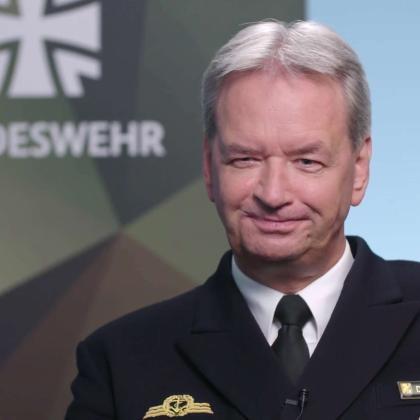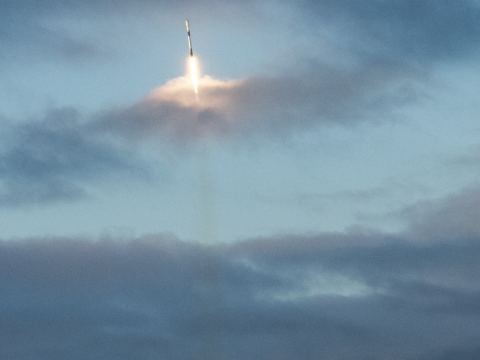It Is Time To Strengthen Multinational Defense Approaches
A more organized and integrated multinational force is needed to confront the adversarial threats of the future. Closer coordination is required across command post structures, unmanned aerial vehicle operations, cyberspace operations, electromagnetic spectrum warfare and other areas, said Vice Adm. Thomas Daum, chief of the German military’s Cyber and Information Domain Service.
Adm. Daum spoke December 5 at AFCEA International’s TechNet Transatlantic conference in Frankfurt, Germany, hosted by AFCEA Europe.
Many lessons are coming from Russia’s illegal invasion of Ukraine, although the vice admiral does not necessarily think this means it is a blueprint for future warfare. What it does mean, however, for command, control, communications, computers, intelligence, surveillance and reconnaissance (C4ISR) is the need for more effective collaboration among the partner nations.
“The Russian war in Ukraine shows that there is a new era in defense, both from a national and from a collective view,” the vice admiral stated. “The war in Ukraine has taught us that modern warfare is just as much about bits and bots as it is about mud and blood,” he continued, quoting the Dutch Admiral Rob Bauer, the outgoing chief of the Military Committee, NATO. “It has quickly become clear that current and future battlefields require reconsidering defense because the time for making decisions is more and more reduced, be it through better and faster reconnaissance.”
And while the concept of outrunning an enemy's decision cycle is not new, Adm. Daum reasoned that digital, information technology (IT) and cyber-related technologies have added a “significant amount of additional momentum” to the battlefield, which, again, requires additional coordination among the cyber and other military operations of NATO’s 32 countries.
Leaders are certainly watching how Russia’s electromagnetic spectrum (EMS) warfare has unfolded over the last two years, and they see how the digital battlefield complicates EMS operations.
“We must, therefore, continue to monitor these developments and develop our own capabilities in an innovative way and close the gaps, ideally with partners to strengthen interoperability and joint efforts,” he noted. “Of course, [it] is evident at this stage that the electromagnetic spectrum is crowded by sensors, IT systems and all sorts of weapon platforms with an increasing number of remotely operated drones. So, there is an urgent need for an EMS order of battle and the means and tools to enforce this order. Of course, this is another collaboration opportunity, but a coordination requirement in a multinational environment.”
Moreover, in his role providing the technology for multidomain operations for Germany’s Cyber and Information Domain Service, Adm. Daum envisions software-defined defense, for example, with tanks becoming a network node on the digitalized battlefield, connected to all other weapons and systems.
He also sees employing AI applications to a good extent, although he recognizes that AI “is a dynamic market right now,” with solutions developing quickly.
German leaders are also implementing zero-trust principles, development security operations, and computing power for multipurposes.

This is something which I, as a leader, cannot risk. So, I need a combat-ready industry that supports military operations, and those services must work in each and every scenario.
As in the United States, Germany faces digital attacks daily from Russia, Iran, North Korea and other nations. “Cyber domain has no border,” he acknowledges. They also see pointed misinformation and disinformation attacks against the German government, military and families, trying to weaken the effectiveness of each.
As such, communication and collaboration are required across the NATO partners to increase cyber defense.
“Attribution is, therefore, key to actions in our domain, more so than other domains,” he explained. “And with this complexity, the distinction between military and civilian actors, between homeland and foreign territory, gets blurred. All of this makes a good case for effective cooperation in our domain, amongst allies and partners, be it military or civility.”
As for a military’s heavy reliance on commercial solutions, such as commercial satellite communications, Adm. Daum emphasized that private sector companies must fully understand the constructs of doing business with the military and the risks and considerations that entails. If they enter into a contract to provide services to the military, companies must ensure those services work in all conditions.
“We are all aware how important Starlink is for the Ukrainian defense,” he said. “With public-private partnerships and [relying] on the industrial side, we must make that ‘combat ready.’ They need to realize if the temperature is rising, there might be a kill chain running over their satellite network, and they might discover that their industrial building somewhere in Germany might become a military target, and that could lead to the fact that an employee leaves and says, ‘I'm not coming back tomorrow.’ But this is something which I, as a leader, cannot risk. So, I need a combat-ready industry that supports military operations, and those services must work in each and every scenario.”
TechNet Transatlantic is organized by AFCEA International in conjunction with the AFCEA Europe office. SIGNAL Media is the official media of AFCEA International.





Comments